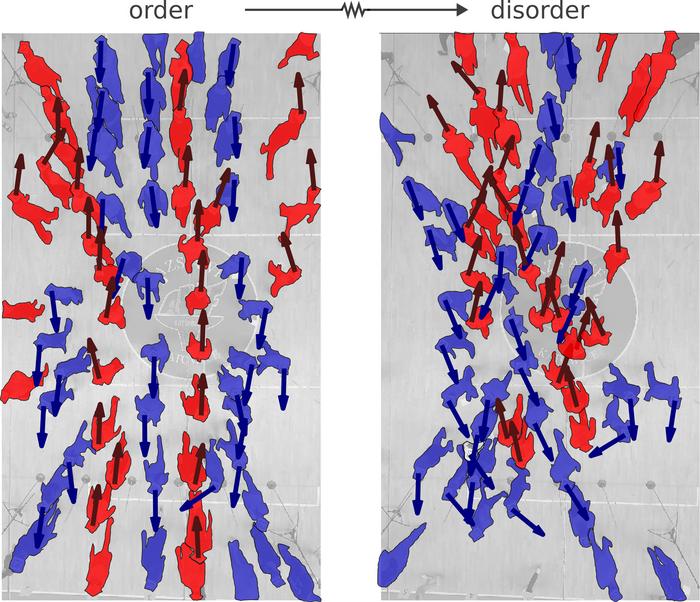Mathematicians have long sought to understand the patterns that emerge within human crowds, leading to breakthroughs that could significantly impact urban design and pedestrian safety. A recent study conducted by a team from the Massachusetts Institute of Technology, led by instructor Karol Bacik, delves into the geometric principles governing pedestrian flow. This work addresses critical questions about crowd dynamics, particularly when pedestrian paths shift from organized lanes to chaotic entanglements. Such insights are crucial, especially in the context of designing public spaces that encourage effective and safe movement.
The research has unveiled a novel approach to predict the conditions under which orderly pedestrian pathways degrade into disordered chaos. By applying mathematical models and engaging in detailed simulations, the researchers examined scenarios commonly encountered in bustling environments, such as busy crosswalks in urban settings. This academic endeavor offers a dual advantage: it not only enhances theoretical understanding but also has practical implications for urban planners and designers aiming to cultivate environments conducive to safe pedestrian navigation.
In a paper published in the prestigious Proceedings of the National Academy of Sciences, Bacik and his collaborators outlined their methodological framework: a merger of mathematical theory with empirical crowd analysis. The researchers investigated a focal point of crowd movement, specifically a busy intersection where pedestrians converge. They used complex calculations along with controlled experiments to analyze pedestrian behavior, tracking how individuals navigate a shared space.
The key parameter identified during their study is termed “angular spread,” which measures how pedestrians disperse in varying directions as they traverse crowded spaces. The analysis revealed that a small angular spread—indicating that individuals predominantly move toward opposing directions—facilitates the formation of clear lanes within the crowd. In contrast, a much larger angular spread leads to disorder, where pedestrians find themselves unable to establish coherent pathways, resulting in potential collisions and delays as movements become erratic.
Interestingly, the researchers discovered a precise angular threshold—approximately 13 degrees—that serves as a pivotal point for this transition between orderly and disordered flow. This cutting-edge calculation demonstrates that if a pedestrian deviates from a straight trajectory by more than this angle, the likelihood of disarray in the crowd significantly increases. This threshold represents a quantifiable insight that urban planners can utilize to enhance pedestrian safety in heavily trafficked areas. Recognizing this tipping point is essential for designing public spaces that minimize risks associated with crowded pathways.
In his reflection on the findings, Bacik emphasized the practical significance of their research. The results indicate a degree of predictability in pedestrian behavior, asserting that the understanding of orderly versus disordered flow can influence how public areas are developed. By fostering an awareness of these crowd dynamics, strategic decisions regarding infrastructure can be made to support easier navigation for pedestrians, thereby improving safety and efficiency within urban contexts.
To validate their theoretical models, Bacik and his team conducted rigorous experiments involving human subjects in a controlled environment. These experiments took place in a gymnasium where participants navigated a marked crosswalk, each donning unique hats with barcodes for tracking purposes. This innovative setup allowed for the meticulous observation of pedestrian pathways and interactions, revealing crucial insights into how crowds function on a micro level.
The results from these experiments corroborated the original hypothesis. When participants displayed a defined angular spread of less than 13 degrees, orderly lanes formed, with pedestrians efficiently moving toward their destinations. However, as they began to traverse at steeper angles, the flow transitioned into a chaotic state, reinforcing the mathematical model previously formulated. This finding serves as a strong argument not only for continued research but also for immediate application to urban design practices.
Moreover, the practical applications of this work extend beyond theoretical implications. Future studies are planned to explore real-world pedestrian environments, leveraging video footage of moving crowds to further assess the viability of their predictive models. This endeavor could potentially lead to developing new guidelines for urban planners seeking to enhance pedestrian experience and safety in crowded locations.
The implications of this research reach beyond a mere academic inquiry into crowd behavior. It intertwines with societal needs for safety and efficiency as urban areas grow denser. As populations migrate toward metropolitan regions, the design of public infrastructure becomes critical for managing pedestrian traffic and minimizing hazards associated with crowd dynamics.
Understanding the nuances of crowd flow not only benefits those who design urban spaces but also impacts policy discussions at a municipal level. As cities prioritize pedestrian safety and well-organized public spaces, insights derived from studies like Bacik’s can inform strategies on how to implement infrastructure that encourages orderly movement, reduces the risk of accidents, and ultimately enhances the quality of urban life for all inhabitants.
Moreover, this ongoing research presents significant prospects for inter-disciplinary collaboration, drawing on insights from mathematics, sociology, and urban planning to create comprehensive models that effectively address complex human behaviors within crowded environments. The intersection of these disciplines opens doors for innovative solutions to traffic congestion and pedestrian safety challenges frequently faced by cities around the globe.
As the team looks ahead, they are enthusiastic about the potential for their findings to shape future urban design principles profoundly. By continuing to refine their models and engage in empirical validation in real-world situations, they aim to contribute significantly to the growing body of knowledge surrounding crowd dynamics and modern urban planning practices.
Ultimately, this research signifies an essential step forward in grasping the complexities of human interactions in crowded spaces. By identifying the mathematical underpinnings that dictate pedestrian behavior, researchers are equipping urban designers with valuable tools to create spaces that foster better movement, enhance safety, and support the seamless functioning of increasingly congested urban environments.
Subject of Research: Predicting pedestrian flow transitions in crowds
Article Title: Order-disorder transition in multidirectional crowds
News Publication Date: October 2023
Web References: DOI link
References: Proceedings of the National Academy of Sciences
Image Credits: Courtesy of Karol Bacik, et al
Keywords: Crowd dynamics, pedestrian flow, urban design, mathematical modeling, safety, angular spread, traffic engineering.




